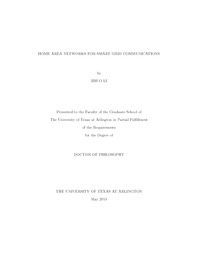
ATTENTION: The works hosted here are being migrated to a new repository that will consolidate resources, improve discoverability, and better show UTA's research impact on the global community. We will update authors as the migration progresses. Please see MavMatrix for more information.
Show simple item record
| dc.contributor.author | Li, Zhuo | en_US |
| dc.date.accessioned | 2014-07-14T20:27:01Z | |
| dc.date.available | 2014-07-14T20:27:01Z | |
| dc.date.issued | 2014-07-14 | |
| dc.date.submitted | January 2014 | en_US |
| dc.identifier.other | DISS-12578 | en_US |
| dc.identifier.uri | http://hdl.handle.net/10106/24439 | |
| dc.description.abstract | his dissertation studies five topic which are focused on but not limited to the area of Home Area Networks (HANs) in Smart Grid communications: capacity optimization for IR-UWB (Chapter 2), power consumption and downlink outage probability in a dynamic HAN (Chapter 3), uplink multiuser selection in a dynamic HAN (Chapter 4), capacity optimization in Heterogeneous HANs (Chapter5), hybrid models of OFDM-based power line and wireless communications for HAN security (Chapter 6), and scaling laws of ergodic capacity for hybrid wireless networks with distributed base stations (DBS) (Chapter 7). We investigate the capacity optimization of Impulse Radio (IR) UWB user within the coexisting operating bandwidth with IEEE 802.11n user, while making sure that its cumulative interference to the coexisting IEEE 802.11n user is below a certain permissible threshold. The optimal power allocation scheme is presented by using water-filling algorithm with Karush-Kuhn-Tucher (KKT) conditions, which is also compared with a traditional equal power allocation scheme. Considering the power saving potential of the emerging WiFi Direct technique, we evaluate the performance of WiFi Direct technique in HANs for Smart Grid Communication from two aspects: power consumption and outage probability. By modeling the traffic intensity and the number of working devices in a dynamic HAN as a Markov chain, the power consumption of the dynamic HAN is evaluated. As to the outage performance, in the downlink of the HAN, the probability density function (PDF) of the signal to interference and noise ratio (SINR) for the active user is derived from the amplitude distribution property of the classical indoor Saleh-Valenzuela (SV) channel. This dissertation also considers the problem of how to optimize the downlink capacity in a heterogeneous HAN with beamforming technique at the smart meter for Smart Grid application. The PDF of the smallest allocated transmit power is mathematically obtained from the properties of downlink indoor S-V channels. It is analytically shown that the allocated transmit power has a lower limit which is determined by the SINR threshold as well as the total number of active users in the HAN. Traditionally, jamming to the wireless in-home system is a fatal threat for Smart Grid communications. To enhance HAN security for Smart Grid application, this dissertation incorporates the OFDM - based power line (PL) system into the HAN, and proposes two hybrid models of PL and wireless communications with transmit diversity and receive diversity, respectively. Finally, a hybrid wireless network with DBS is designed to improve the spectrum efficiency. It is analytically shown that compared to the traditional hybrid wireless network, the ergodic throughput capacity of hybrid wireless networks with DBS scales with gain with N x NBS. | en_US |
| dc.description.sponsorship | Liang, Qilian | en_US |
| dc.language.iso | en | en_US |
| dc.publisher | Electrical Engineering | en_US |
| dc.title | Home Area Networks For Smart Grid Communications | en_US |
| dc.type | Ph.D. | en_US |
| dc.contributor.committeeChair | Liang, Qilian | en_US |
| dc.degree.department | Electrical Engineering | en_US |
| dc.degree.discipline | Electrical Engineering | en_US |
| dc.degree.grantor | University of Texas at Arlington | en_US |
| dc.degree.level | doctoral | en_US |
| dc.degree.name | Ph.D. | en_US |
Files in this item
- Name:
- Li_uta_2502D_12578.pdf
- Size:
- 1.234Mb
- Format:
- PDF
This item appears in the following Collection(s)
Show simple item record


